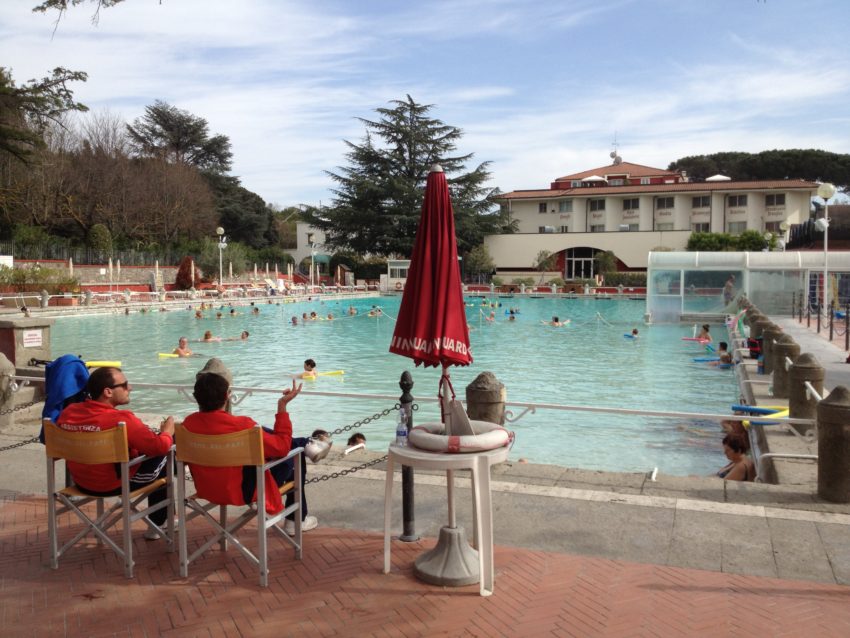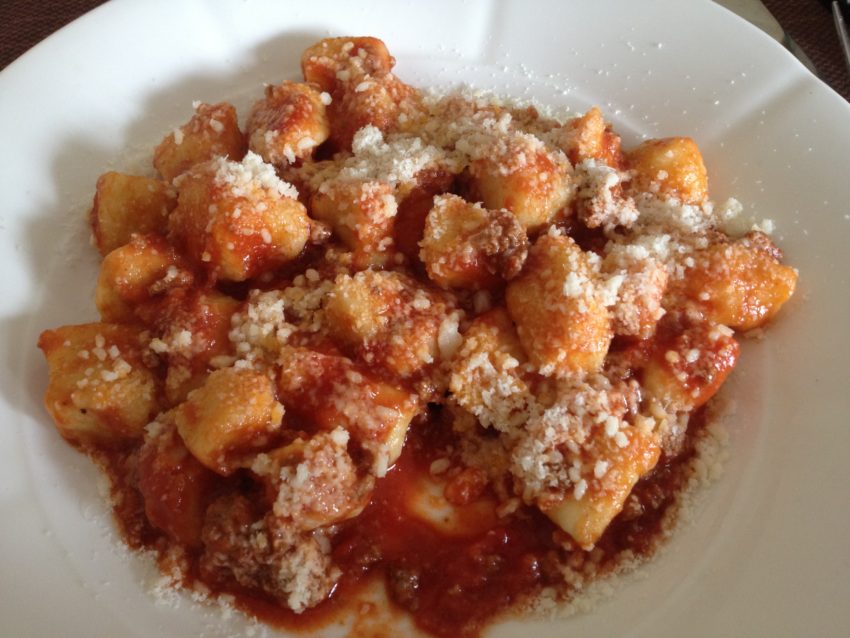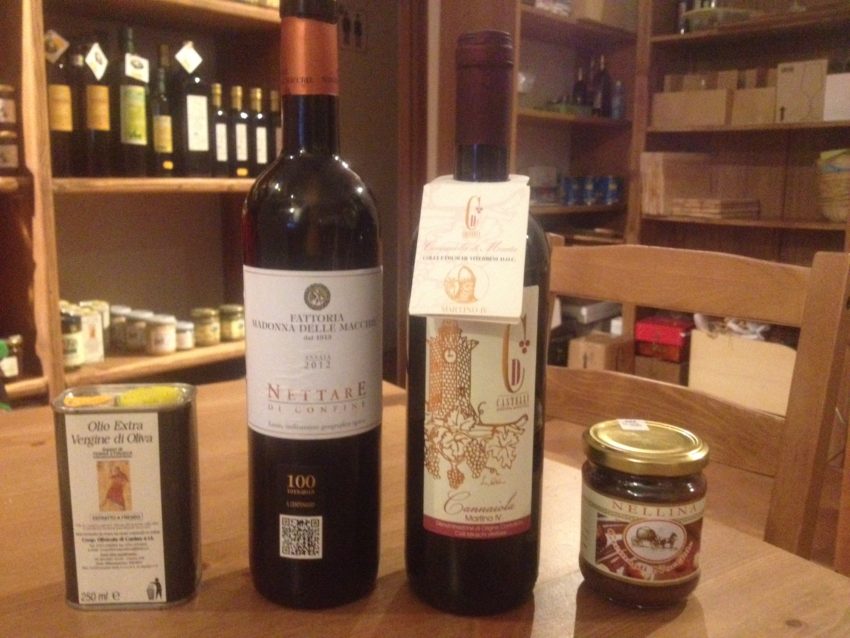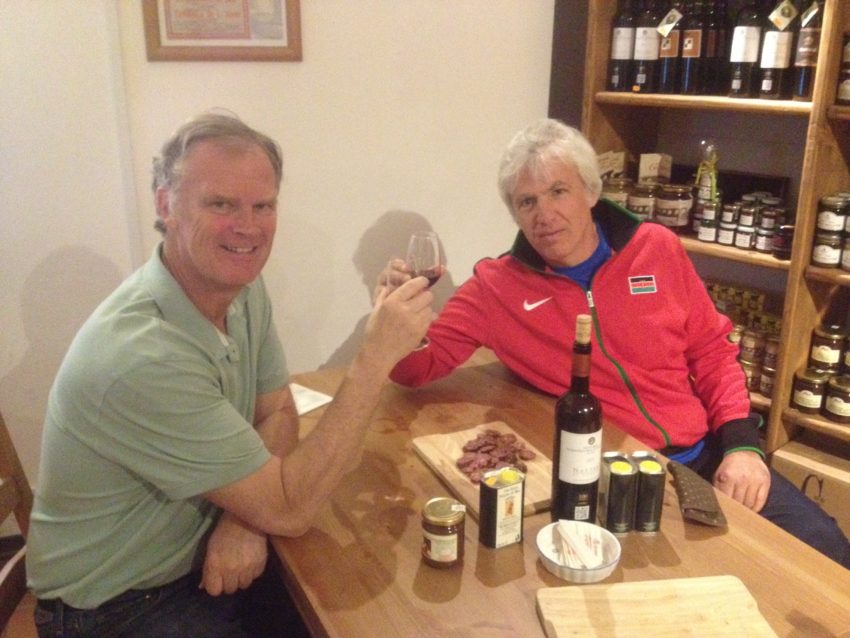Retired in Rome Journal: Thermal baths of Viterbo means floating in the wake of Michelangelo





APRIL 4
VITERBO, Italy — Back in the late ‘90s, when I was just stretching my wings as a travel writer, I wrote a well-received story about Rome off the beaten path. I included a number of fabulous ideas, ranging from a pasta museum in the middle of Rome to Tivoli, a small fountain-filled town where the Ancient Roman aristocracy escaped the city. I left out one, one I visited yesterday and will continue to frequent whenever I get tired of marble and cobblestones and Italian bureaucracy.
The Terme dei Papi are thermal baths located in the charming walled city of Viterbo, about 40 miles north of Rome. Actually, the baths were once on the beaten path. The difference is those beating that path were the likes of Michelangelo, Dante Alighieri (who wrote about them in his “Divine Comedy”) and, as the term “Papi” indicates, many sitting popes. They’ve been around since the 3rd century, just after the height of the Roman Empire.
I went with Alessandro Castellani, my good sportswriter buddy with ANSA, Italy’s wire service. He’s one of the born-and-bred Romans who remains proud of his city despite the difficult working lives Romans lead. Lui e’ un romano per romani (He’s a Roman for Romans.), not to mention a fine writer.
He insisted we first visit this restaurant he’d been raving about since I arrived in Rome nearly three months ago. Felicetta has been around since 1920 and in its present location, a simple, vine-covered two-story structure surrounded by ombrella and pine trees, since 1969. Alessandro said Felicetta serves the best gnocchi in Italy. When Alessandro talks about “bests” and “food” in the same sentence, you listen. He knows where the best mushrooms, truffles, pizza, pasta carbonara and olive oil around. What’s interesting about male friendships in Rome is the range of subjects I discuss are far more ranging than what I had in Colorado where they pretty much revolved around women, sports and, well, women. With Alessandro and my other male friends, we have deep, involved, detailed conversations about food. And wine. Even bread. On the 90-minute drive from Rome, we spent 15 minutes discussing the pluses and minuses of Tuscans making bread with no salt. (For centuries, Tuscans had to pay a salt tax. Thus, they stopped using it. They still don’t. I think their bread is horribly bland but Tuscans believe its bread brings out more flavor in the cheese, salami and olive oil you eat on it.)
At lunch Felicetta was populated by some members of the Italian military (an air force base is nearby) whose fatigues even look stylish, not surprising in this country. Behind us were some old regulars and a guy in a suit who curiously ordered just a salad.
“Look at that guy,” Alessandro said. “How can you be in a place with the best gnocchi in the world and eat nothing but a salad?”
Gnocchi isn’t easy to make and it’s even harder to keep. Gnocchi (it comes from the Italian word “nocca” or knuckle) is small, light potato dumplings you top with everything from cheese sauce to vegetables to sage to various meats. It comes from Northern Italy, where it’s colder and the comfort food is heavier. But it has become a staple from the Alps to Sicily and is especially popular in Rome where simple ingredients hold reign.
How long does it last? Thursday is considered Gnocchi Day in Italy. That’s when it’s made. That’s when it’s eaten. That’s when what’s little left is thrown out. We came to Felicetta on Thursday.
Alessandro is an expert on rugby. He is now an even bigger expert on gnocchi. The dish presented to me was simply a work of advanced art. The sauce was made of garden-fresh tomatoes sprinkled with meat and topped with generous, thick shavings of parmesan. Every bite was a new experience in gastronomic ecstasy. I enjoyed it to the point where I ate it one dumpling at a time. I didn’t want it to disappear. They later brought us a pork steak and a link of sizzling sausage with less fat than the best, lean steaks I’ve had in the U.S. It was better than any sausage I’ve had in Germany. Alessandro and I ate and swooned at the table as if regaling each other with great sexual tales from the past. For 7.00 euro (about $9.50), the gnocchi is one of the best bargains in metro Rome.
The best part about it? The gnocchi didn’t stuff us. We didn’t waddle into the baths. They’re just up the street and remind me of the hot springs in Glenwood Springs. They’re the same general size and temperature with the piping-hot, 136-degree water pumping out of pipes at one end and cooler swimmable water at the deeper other 10-foot deep end. But Terme dei Papi has history. Viterbo was once called Surrena and a road led right to these waters which the Etruscans used for therapeutic purposes. When the Roman army ran roughshod over the Etruscans, they left the steaming hot waters alone and used them as their own escape. They felt great after a good slaughter.
Since then so many reigning popes have visited, they fly the yellow and white Vatican flags over the entrance. It’s also remarkably quiet. Romans know how to relax and the entire pool was populated by adults floating aimlessly on those curved floatable bands of styrofoam. A middle-aged mentally retarded man couldn’t stop smiling as his elderly parents slowly pushed him around the pool.
The facility provides bathrobes and stylish Romans would take combs and brush their hair back as they sat regally on lounge chairs at pool side. Suddenly, I no longer cared that it’s been nearly three weeks and Italy’s sloth-like services have yet to notify me that they’ve awoken from an obvious coma and will put Internet in my apartment.
After three hours turning into limp dishrags, we dragged ourselves into the car and took a little walk through Viterbo. It still has its Old World charm with an ancient Roman wall surrounding it and a narrow pedestrian walk going right through town. We settled into a little wine and cheese shop called Ejelo. The name means nothing. Even the long-time owner couldn’t explain it. What it should mean is an Etruscan word for “hospitality.” Alessandro and I sat down at a table and the woman brought us a bottle of Nettaro di Confini, a delicious local wine that we served each other at our desire. As we collected what Alessandro called “some of the best olive oil in Italy” and a delicious hazelnut-chocolate spread called Nellina, the owner chopped us up fat chunks of cinghiale, wild boar which roam wild in this countryside.
In the future, so will I.


April 29, 2014 @ 6:11 am
Hello Mr Henderson! it is with great pleasure that we read your report on Viterbo and we thank you for the compliments to Ejelo, la bottega del Gojo.
We would like to let you know that our shop of typical products of Tuscia, it’s also special in the name. The name “Ejelo, La bottega del Gojo”, in the local dialect means “Here it is, the store of the Crazy Man” and both “Ejelo” and “gojo” are the most common words in Viterbo.
We hope to see you again here and thank you again!
Ejelo’s staff
April 29, 2014 @ 7:32 am
ciao John, glad you discovered our local “country club”, the relaxing terme. We lucky people who live just 5 min. away use it as a weekly spa and rejuvenation day.